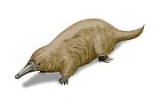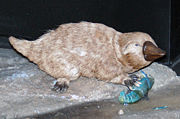
Steropodon
Encyclopedia
Steropodon galmani was a prehistoric species
of monotreme
, or egg-laying mammal
, that lived during the middle Albian
stage, in the Lower Cretaceous
period. It is the second-earliest known relative of the Platypus
.
 Steropodon is known only from a single opal
Steropodon is known only from a single opal
ised jaw
with three molar
s, discovered at the Griman Creek Formation, Lightning Ridge, New South Wales, Australia, by brothers David and Alan Galman. It was a large mammal
for the Mesozoic
, being 40–50 cm long. The lower molars are 5–7 mm in length, with a width of 3–4 mm. A length of 1–2 cm is more typical for Mesozoic mammals. Also from Lightning Ridge is Kollikodon ritchiei
.
The molars "bear striking resemblance to the tribosphenic pattern characteristic of living theria
ns..." (Pascual). However, there are also differences: there is no entoconid, and an absence of wear seems to suggest that the upper molars (as yet unknown) did not have a protocone
, and so implying that there was a double origin of tribosphenic teeth, one group represented by the living placentals and marsupials, and the other group being the monotremes bearing 'pseudo-tribosphenic' teeth.
Woodburne (2003, p. 212) reports that the holotype
is a right mandible named AM F66763. The preserved molars are m1–m3. Page 237 includes: "In Steropodon, the mandibular canal suggests the presence of a bill, with a bill also known in Obdurodon dicksoni
and Ornithorhynchus anatinus
."

Species
In biology, a species is one of the basic units of biological classification and a taxonomic rank. A species is often defined as a group of organisms capable of interbreeding and producing fertile offspring. While in many cases this definition is adequate, more precise or differing measures are...
of monotreme
Monotreme
Monotremes are mammals that lay eggs instead of giving birth to live young like marsupials and placental mammals...
, or egg-laying mammal
Mammal
Mammals are members of a class of air-breathing vertebrate animals characterised by the possession of endothermy, hair, three middle ear bones, and mammary glands functional in mothers with young...
, that lived during the middle Albian
Albian
The Albian is both an age of the geologic timescale and a stage in the stratigraphic column. It is the youngest or uppermost subdivision of the Early/Lower Cretaceous epoch/series. Its approximate time range is 112.0 ± 1.0 Ma to 99.6 ± 0.9 Ma...
stage, in the Lower Cretaceous
Cretaceous
The Cretaceous , derived from the Latin "creta" , usually abbreviated K for its German translation Kreide , is a geologic period and system from circa to million years ago. In the geologic timescale, the Cretaceous follows the Jurassic period and is followed by the Paleogene period of the...
period. It is the second-earliest known relative of the Platypus
Platypus
The platypus is a semi-aquatic mammal endemic to eastern Australia, including Tasmania. Together with the four species of echidna, it is one of the five extant species of monotremes, the only mammals that lay eggs instead of giving birth to live young...
.

Opal
Opal is an amorphous form of silica related to quartz, a mineraloid form, not a mineral. 3% to 21% of the total weight is water, but the content is usually between 6% to 10%. It is deposited at a relatively low temperature and may occur in the fissures of almost any kind of rock, being most...
ised jaw
Jaw
The jaw is any opposable articulated structure at the entrance of the mouth, typically used for grasping and manipulating food. The term jaws is also broadly applied to the whole of the structures constituting the vault of the mouth and serving to open and close it and is part of the body plan of...
with three molar
Molar (tooth)
Molars are the rearmost and most complicated kind of tooth in most mammals. In many mammals they grind food; hence the Latin name mola, "millstone"....
s, discovered at the Griman Creek Formation, Lightning Ridge, New South Wales, Australia, by brothers David and Alan Galman. It was a large mammal
Mammal
Mammals are members of a class of air-breathing vertebrate animals characterised by the possession of endothermy, hair, three middle ear bones, and mammary glands functional in mothers with young...
for the Mesozoic
Mesozoic
The Mesozoic era is an interval of geological time from about 250 million years ago to about 65 million years ago. It is often referred to as the age of reptiles because reptiles, namely dinosaurs, were the dominant terrestrial and marine vertebrates of the time...
, being 40–50 cm long. The lower molars are 5–7 mm in length, with a width of 3–4 mm. A length of 1–2 cm is more typical for Mesozoic mammals. Also from Lightning Ridge is Kollikodon ritchiei
Kollikodon
Kollikodon ritchiei is a fossil monotreme species. It is known only from an opalised dentary fragment, with one premolar and two molars in situ...
.
The molars "bear striking resemblance to the tribosphenic pattern characteristic of living theria
Theria
Theria is a subclass of mammals that give birth to live young without using a shelled egg, including both eutherians and metatherians . The only omitted extant mammal group is the egg-laying monotremes....
ns..." (Pascual). However, there are also differences: there is no entoconid, and an absence of wear seems to suggest that the upper molars (as yet unknown) did not have a protocone
Protocone
thumb|500px|right|Right upper molar showing the four main upper molars cusps.The protocone is a cusp of the molars of the upper dentition in Placental and Marsupial vertebrates .It is found at the mesiolingual area of the tooth...
, and so implying that there was a double origin of tribosphenic teeth, one group represented by the living placentals and marsupials, and the other group being the monotremes bearing 'pseudo-tribosphenic' teeth.
Woodburne (2003, p. 212) reports that the holotype
Holotype
A holotype is a single physical example of an organism, known to have been used when the species was formally described. It is either the single such physical example or one of several such, but explicitly designated as the holotype...
is a right mandible named AM F66763. The preserved molars are m1–m3. Page 237 includes: "In Steropodon, the mandibular canal suggests the presence of a bill, with a bill also known in Obdurodon dicksoni
Obdurodon
Obdurodon is an extinct monotreme genus containing three species. Obdurodon differed from modern platypuses in that it had molar teeth .-Obdurodon dicksoni:...
and Ornithorhynchus anatinus
Platypus
The platypus is a semi-aquatic mammal endemic to eastern Australia, including Tasmania. Together with the four species of echidna, it is one of the five extant species of monotremes, the only mammals that lay eggs instead of giving birth to live young...
."
See also

- Fossil monotremes

